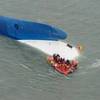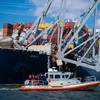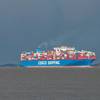The process of bioremediation of waste oil through patented biodispersion technology, consists of a breakthrough in ballast water treatment, which has been discovered via research based on the evaluation of SpillRemed (Marine), which was developed on the basis of biodispersion technology for remediation of bilge water on boats and ships in an effort to develop an environment friendly solution to the problem of operational discharges by ships.
A study was conducted on board cruise ships equipped with oil water separators. SpillRemed (Marine) is considered a suitable replacement to chemical dispersants.
Although in volumes as large as found on such ships, it is not possible to completely remediate the bilge water, by dispersing the oil in the water it will be possible to improve the separation of oil water separators.
The following is a selection of preliminary results based on the research conducted on a variety of ship types.
Introduction
According to a United Nations Environment Program survey of 1997, more than 30,000 mt of oil is released in the oceans every year. Ships contribute a very small share of 12 percent through discharges regulated by the MARPOL 73/78, which has been accepted by most of the maritime and flag nations in the world.
Bilge water stored in the bottom part of the ships does not contribute in this for the simple reason that ships are not allowed to discharge bilge water containing more than 15 ppm of oil.
This has put heavy responsibility on the ship operators. In order to achieve the international standards of discharge, the ships will have to install oil water separators to separate oil and discharge water as per the international guidelines. The ships will have to keep the waste oil exceeding the above limit in their holds and should discharge only at receiving facilities available at each port.
However, there have been a couple of incidents where these discharges have been made by the ships in violation of the guidelines indicating that these ships may have found it difficult to follow the protocol since it affected their schedule or from operational necessity. Bilge water is probably the single largest source of waste oil produced from maritime activities, and it does not find any special use on shore. Yet it imposes a great burden on the ships and ports for collecting and disposal of the waste oil. Federal bodies like navies have their own facilities on shore where the naval ships can unload their bilge water without ships paying for the facility, but that is not the case with private operators.
The problem of bilge water disposal is same for small boats and their operators as for the bigger ships.
In situ Remediation through
Biodispersion Technology
In view of such vast amounts of oil present in association with water, there is a need to treat this pollution at source and help reduce the "hidden" overheads incurred in treating oil pollution. Remediation at source needs to have the following properties to be a successful solution:
• Should be environmentally safe
• Should be Fast acting and remediation should take place in days.
• Should not disturb the existing ecosystem.
• Should be available in a Ready-To-Use (RTU) form
• Should not require supplementary addition of nutrients.
• Should require little or no human intervention.
• Should not contain any genetically modified bacteria
Products developed on the basis of patented 'Biodispersion' technology developed by Sarva BioRemed is one such solution to the problem by treating waste oil on site without affecting the environment. SpillRemed (Marine) and SpillRemed (FreshWater) can be employed in salt water or fresh water situation respectively.
Both these products are available in a Ready To Use (RTU) form and the treatment does not require any addition of nutrients.
Remediation of Bilge Oil on a Cruise Ship
Unlike studies on boats, studies on larger vessels were carried out in three phases namely, bench scale studies, compatibility studies and direct service trial.
Bench Scale Studies
Samples of bilge oil were directly collected from the cruise ship during transfer of the oil to the receiving facility. The oil was thick, black, viscous and hot at the time of collection suggesting that a greater component of low boiling point fraction may have been removed during transfer. The thick oil was brought to the laboratory and a small quantity was added to a fish tank containing 20 gallons of salt water
The water was aerated using a fish tank bubbler locally available. It was found that the oil became uniformly dispersed in 48 hours of time suggesting that SpillRemed (Marine) was effective on the complex mixture of oil and was under active remediation.
Compatibility Studies
Once it was observed that SpillRemed (Marine) was effective on the complex mixture of oils in the bilge, it was decided to explore the possibility of using SpillRemed (Marine) in the bilge tank equipped with an oil water separator manufactured by Marine Floc of Sweden. The Superintendent Engineer of the cruise line suggested that we determine the compatibility of SpillRemed (Marine) with the OWS as a first step in the trials on board their ship. Sample of SpillRemed (Marine) was sent to MarineFloc for their evaluation of compatibility with their OWS. The manufacturing company carried out their evaluation and submitted their report indicating that SpillRemed (Marine) was compatible with their OWS. Report of the manufacturer is submitted as an appendix to the paper.
Ship Board Trials
The ship board trials were initiated after completion of all the above formalities and the Superintendent Engineer was shown the test reports. A total of 200 liters of SpillRemed (Marine) was supplied to the ship. Although the ship left New York, the trials actually began on the return journey to Florida.
The bilge water contained 30 percent of oil and the volume was 10 tons of water in 80-ton sludge tank.
Sponsored Content
Chris-Marine’s solutions help to prolong engine lifetime

AST is now AST Networks, bringing you remote connectivity wherever you are

March 2024
 Read the Magazine
Read the Magazine

 Read the Magazine
Read the Magazine
This issue sponsored by:

GAO: Coast Guard Should Better Monitor its Efforts to Credential Merchant Mariners
Subscribe for
Maritime Reporter E-News
Maritime Reporter E-News is the maritime industry's largest circulation and most authoritative ENews Service, delivered to your Email five times per week












